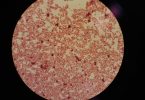 Flash memory is hot right now. It’s inside every USB stick you receive at a conference. Your digital camera saves every photo you take onto a flash-powered SD card. Flash powers that solid-state drive you put into your computer so it can boot in just 10 seconds. Flash memory is durable, compact and cheap. Sadly, we’ve started to reach the limits of how far we can push flash based memory, in terms of both speed and capacity.
Flash memory is hot right now. It’s inside every USB stick you receive at a conference. Your digital camera saves every photo you take onto a flash-powered SD card. Flash powers that solid-state drive you put into your computer so it can boot in just 10 seconds. Flash memory is durable, compact and cheap. Sadly, we’ve started to reach the limits of how far we can push flash based memory, in terms of both speed and capacity.
Researchers at RMIT’s city campus have just built the foundation for what could be the next great leap in memory technology. They’ve constructed a nanometrte-thin stacked structure out of thin film, an oxide more than 10,000 times thinner than a human hair.
The device uses memristors, electrical resistors that resist at different strengths depending on how much current flowed through last time. Many academics believe that this technique will allow the construction of memory which functions more organically, including perhaps the much discussed idea of “learning memory” which would be required to achieve an artificial equivalent of the human brain.
The project’s leader, Dr Sharath Sriram, said the film was designed with defects in its chemistry, to allow it to demonstrate its memristive effects.
“With flash memory rapidly approaching fundamental scaling limits, we need novel materials and architectures for creating the next generation of non-volatile memory,” he said.
“The structure we developed could be used for a range of electronic applications – from ultrafast memory devices that can be shrunk down to a few nanometres, to computer logic architectures that replicate the versatility and response time of a biological neural network.
“While more investigation needs to be done, our work advances the search for next generation memory technology (that) can replicate the complex functions of human neural system – bringing us one step closer to the bionic brain.”
The research was conducted by RMIT’s Functional Materials and Microsystems Research Group (of which Dr Sharath Sriram is a co-founder) and Professor Dmitri Stukov, from the University of California, using a grant from the Australian Research Council.



